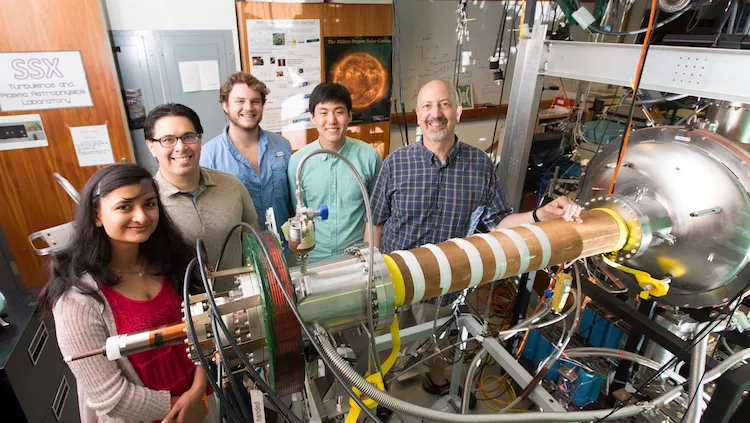Physicist Mike Brown and the Search for an Eternal Energy Source

Morris L. Clothier Professor of Physics Michael Brown (right) with students in his lab in the Science Center at Swarthmore College.
Scientia: Literal Sun Jars: Shrinking Jars for Energy Production
While most of the energy we use can be traced back to nuclear fusion in the Sun, researchers such as [Morris L. Clothier Professor of Physics] Michael Brown and his team at Swarthmore College, Pennsylvania, are trying to recreate this process here on Earth. As you might imagine, the problem is not a trivial one: "Attaining fusion on Earth requires achieving stellar densities and temperatures, and holding both for a substantial period of time," Professor Brown explains. Harnessing the process that the Sun uses to produce its energy has the potential to outshine all other sources of energy on Earth.
...
Professor Brown and his team work on a project known as the Swarthmore Spheromak Experiment (SSX), which is supported through the ARPA-E ALPHA project and aims to explore a process known as Magneto-Inertial Fusion. Magneto-Inertial Fusion, or ‘MIF’, is an intermediary approach, somewhere between ICF and MCF, which Professor Brown describes as "a new approach to fusion energy, to generate small parcels of hot magnetic plasma, then compress them, like when petrol is compressed in a car engine."
"Mainline fusion efforts cost several billion dollars," Brown adds. "What we are working on is risky but potentially much cheaper." These small parcels of plasma essentially contain the same ingredients as the centres of stars but are on the same scale as the Sun jars mentioned earlier. To create these literal Sun jars, Professor Brown and his team of researchers are investigating the use of something they call a ‘Twisted Taylor State’ as the fusion medium.
...
Although the project is far from complete, Professor Brown and his team have already made some promising progress: ‘We have completed analysis of compression events of our un-accelerated Taylor State and have identified a good model EOS,’ he says. ‘Results are being reported in two papers under review.’ This model EOS will be used to guide their experiment when they begin to ramp up to more extreme states of compression that are more in tune with what’s expected for the nuclear fusion process to start. ‘When we push to more extreme compression, we will be guided by our EOS to predict densities, temperatures, and magnetic fields,’ Professor Brown explains.
On the future of the project, Professor Brown is optimistic. He feels that his team is in a strong position to complete their work during the second half of the project: "Our postdoc, Manjit Kaur, now has over a full year of experience, and we have assembled a team of talented collaborators including Swarthmore students, the simulation team, and Bryn Mawr Professor David Schaffner." With the ability to satisfy society’s energy needs through this new method of clean energy generation, it’s no understatement to say that the work being undertaken by Professor Brown and his students has the potential to change the course of human history.
Michael Brown is Morris L. Clothier Professor of Physics. His research interests are plasma physics, experimental physics (SSX), plasma turbulence, magnetic reconnection, solar physics, and fusion. For more than 20 years, Brown has explored astrophysical phenomena in the Swarthmore Spheromak Experiment Lab. He has guided over 40 undergrads through all aspects of the scientific research process, from designing and conducting experiments to writing and publishing papers.
Swarthmore is investing in its vibrant intellectual culture. Learn how at lifechanging.swarthmore.edu.



